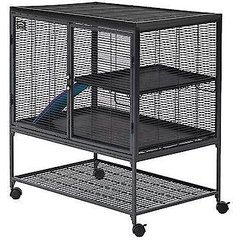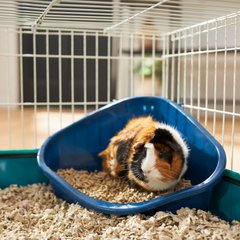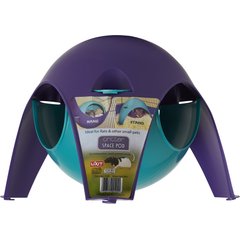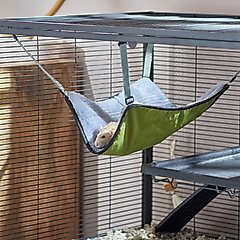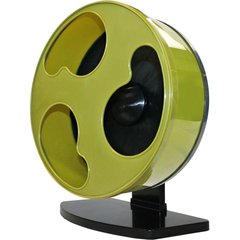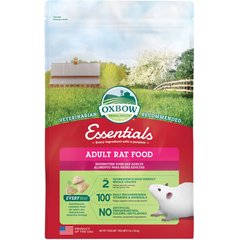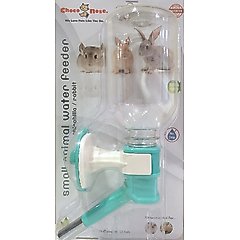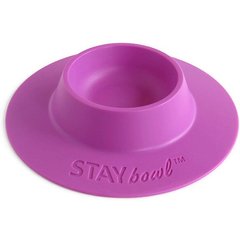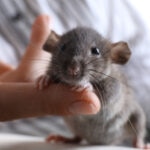Pet Rat Care Sheet
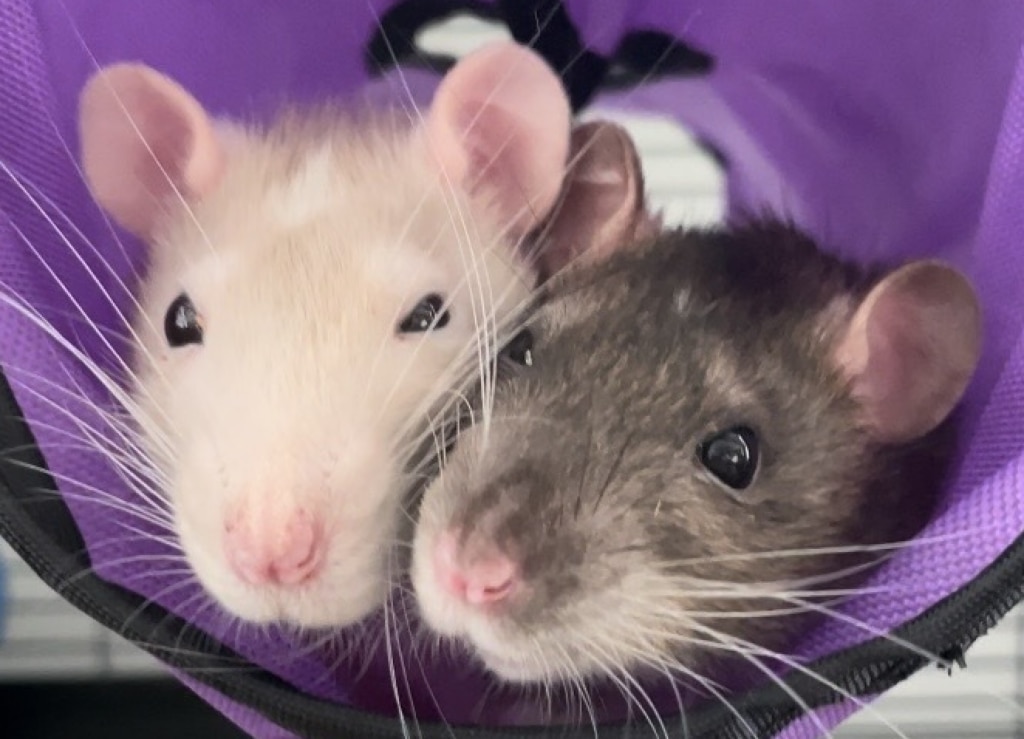
Photo by Emily Holowczak
Rats are intelligent, loyal, and great pets. Whether you’re caring for a baby, adult, or senior rat, you should know a few things to ensure they live a long and healthy life.
Rat Overview
- Rats can grow up to 18 inches long, weighing about 1 pound.
- There are about 60 rat species.
- The life expectancy of a rat is typically 2 to 3 years.
Fun Facts About Rats
- Rats need gnawing objects to keep their teeth healthy and trimmed.
- Rat whiskers are super sensitive and help rats navigate in the dark.
- These rodents thrive in groups and do best when they live with at least one other rat.
Rat Habitat
Rats need large, multilevel wire cages and plenty of space to move around. Find an enclosure at least 20 inches long, 14 inches wide, and 24 inches high. The MidWest Critter Nation Deluxe Small Animal Cage is commonly recommended by rat enthusiasts. You can even add levels if you have more than one rat.
Recommended Product
The cage should have a solid bottom and the bar spacing should be no bigger than 1/2 inch. Otherwise, your pet rat could escape. While most rats can grow to about 1 pound, they can fit their bodies into very tight spaces.
Rats love cohabitating with other rats, so keep them together in pairs or groups. Your rats will likely interact with each other with cute behaviors like play wrestling, grooming, and even sleeping on top of each other. Though rats may squeak while playing, make sure to monitor groups for more aggressive behavior like harsh biting and a puffed-up stance.
Temperatures should be between 65–80 F. Don’t let temperatures fluctuate too much, as rats’ small bodies don’t handle major temperature changes well. Keep enclosures away from drafty areas and direct sunlight.
Rats should have about 2 inches of paper-based or hemp bedding at the bottom of their cage. Avoid wood shavings or chips, which could harm your rat’s gastrointestinal tract if eaten. Choose a bedding that is free of fragrance, as rat respiratory systems are very sensitive.
Recommended Products
Rats can be litter box trained. They naturally like to go to the bathroom in the same spot, generally in a corner.
For best results, place a litter box in a corner of each level of their cage and use a different bedding in the pan than the rest of the cage. This way, rats associate the specific litter with their bathroom area.
Recommended Product
For example, use a pellet litter in the litter boxes and use hemp, which rats like to burrow in and use for nests, in the rest of the cage.
Rats love toys! Make sure your pet rat has enough accessories to keep them occupied in their cage. Add a hideaway box, running wheel (make sure it has a solid track—not mesh wire), climbing ladders, various PVC tubes, and cardboard. Rotate toys frequently to keep your pet rat’s brain stimulated as much as possible.
Recommended Products
Spot-clean your rat’s cage daily. Thoroughly clean the entire cage at least once a week, replacing all bedding and wiping it down with a pet-safe cleaner like Nature’s Miracle Small Animal Cage Cleaner Spray.
Recommended Product
Pet Rat Diet
A pet rat’s diet should mostly consist of dried rat pellets, but they can also eat fresh fruits and veggies. Fresh food should make up about 10% of your pet’s diet. Most of their meals should be high-quality commercial rat pellets.
Recommended Products
Do not exclusively feed seed mix diets—although these are marketed to small pets, they are not nutritionally complete.
Rats must eat twice a day, with meal sizes varying based on age and size. Follow the pellet food’s feeding guidelines to avoid overfeeding.
Keep fresh water available at all times. Clean your pet’s water bottles and food dish daily to prevent bacterial growth.
Recommended Products
Senior rats tend to eat less than baby and adult rats, and they aren’t as active as when they were young. Keep track of their eating and activity levels to see if more than just age is cause for concern.
Pet Rat Handling
Rats love socialization, community, and attention. Find the time to handle your rat daily to encourage stimulation and bonding.
Let your pet come to you. When your rat shows an interest in being held, scoop them up from underneath and make sure their hindquarters have enough support. Some rats may even “groom” their pet parents by gently licking your fingers.
Rats can also spend time outside of their cage without being held. Creating a safe area for them to roam around without escaping encourages development. Make sure to provide barriers to keep rats in a controlled area, away from electrical outlets and wires.
Rat Health
When healthy, rats usually live as long as 2 to 3 years. Signs of a healthy rat include:
- Clean and clear eyes, nose, and ears, free of discharge
- A shiny and smooth coat
- Regular bowel movements
- Curious, social personality
- Weight proportionate to their body size
- Nails and teeth that aren’t overgrown
Contact a vet if you notice any worrisome signs, like:
- Concerning or rapid weight loss
- Changes in appetite
- Low energy levels
- Breathing changes, wheezing, or sneezing
- Chewing on their own hair
- Overgrown teeth
- Mammary tumors
- Skin issues, lumps, or bumps
- Hind-end paralysis
Take your pet rat to a vet at least once a year for a regular checkup. Even if they appear to be healthy, the vet can evaluate them for potential health concerns.
For baby rats, visit your vet every six months for the first 18 months of life to improve their lifespan and catch any potential issues before they start.
If you’re struggling to find a vet, contact a local veterinarian’s office to see if they can recommend one with experience in rat and rodent care.
Pet Rat Supply Checklist
Before bringing your rat home, set up your space so your new pet will thrive. Get all your supplies, including:
- A large enclosure with appropriately spaced bars
- Paper bedding
- Decor and accessories
- Exercise wheels and enrichment toys
- High-quality pelleted rat food
- Food and water bowls
- Water bottle
- Chew toys
- Cage cleaner
- Small pet carrier
FAQs About Pet Rats
Do rats make good pets?
Rats make great pets. They are highly intelligent and loyal rodents who enjoy interacting with you.
What is a fancy rat?
Fancy rats are domesticated brown rats. These social rodents bond well with humans.
How long do rats live for?
Rats commonly live 2 or 3 years.
Are pet rats clean?
Rats are relatively clean pets. Regularly clean their enclosures, with daily spot-cleaning and a more thorough cleaning at least once a week.
How big does a pet rat get?
Pet rats can get up to 18 inches long, including its tail, and weigh more than a pound.
How long do rats sleep?
Rats sleep anywhere from 12 to 15 hours a day.
Click here for a printable PDF version of this care sheet!
